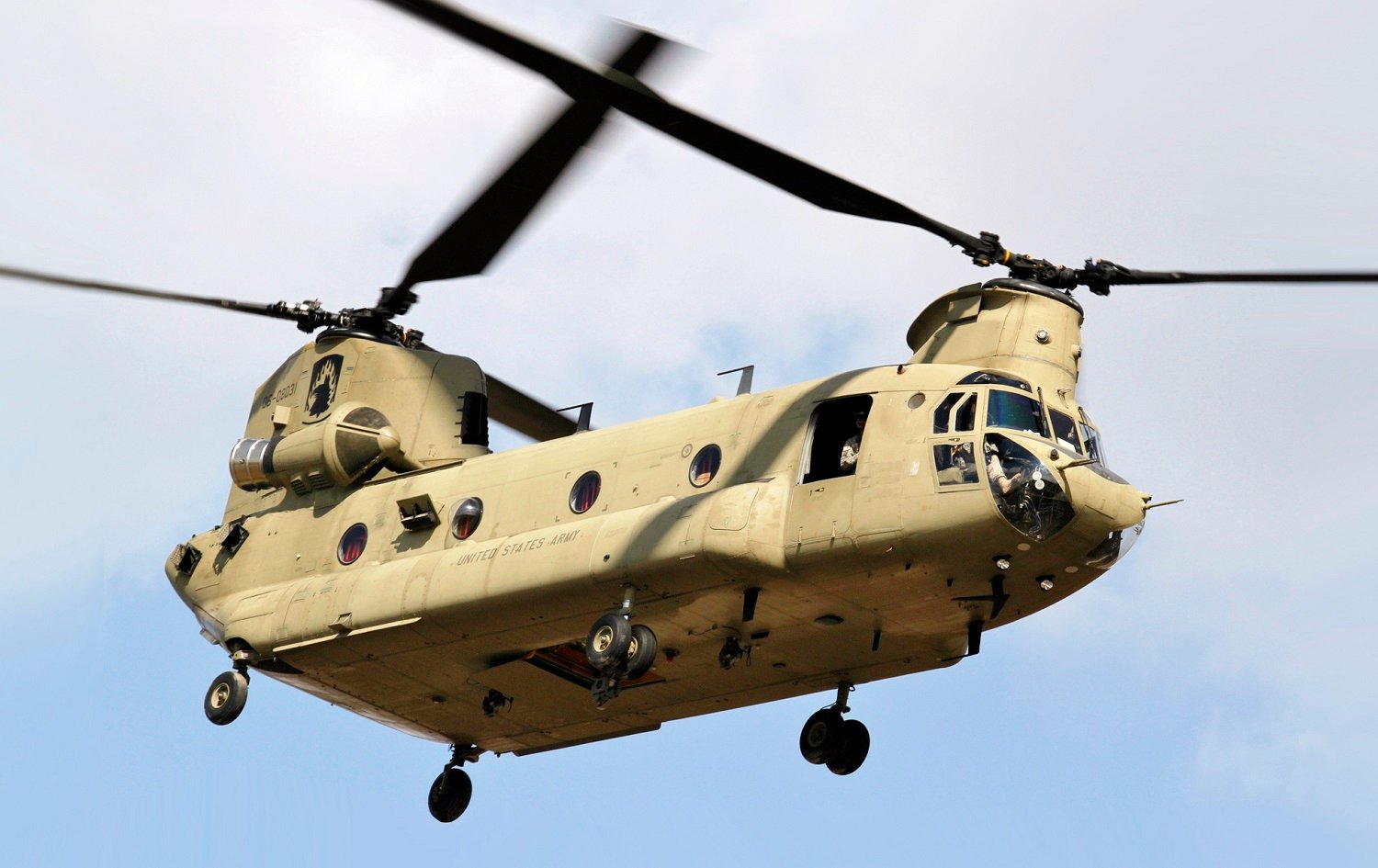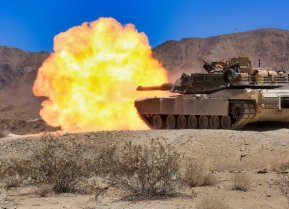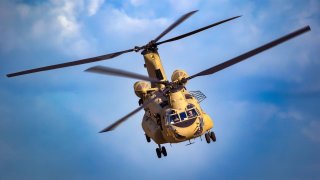China Offered Taiwanese Pilot $15 Million to Steal U.S.-Made CH-47 Helicopter
A Taiwanese pilot, accused of spying for China and arrested in August, was reportedly offered $15 million to defect by landing a U.S.-made CH-47 Chinook helicopter on the flight deck of a People's Liberation Army Navy (PLAN) aircraft carrier.
A Taiwanese pilot, accused of spying for China and arrested in August, was reportedly offered $15 million to defect by landing a U.S.-made CH-47 Chinook helicopter on the flight deck of a People's Liberation Army Navy (PLAN) aircraft carrier.
The South China Morning Post reported that the pilot, named Lt. Col. Hsieh of the Republic of China Army (ROCA), was approached in June by mainland Chinese intelligence officials through a retired Taiwanese army officer to defect with a helicopter while the PLAN conducted a drill near the self-ruling island.
"According to the instruction from the [mainland] agents, Lieutenant Colonel Hsieh was asked to fly the helicopter at low altitude along the coastline to the Chinese Communist carrier which would be staging drills close to the waters 24 nautical miles [44km] off [Taiwan]," the Taiwan High Court Prosecutors Office said in an indictment revealed by lawmakers on Monday.
It is unclear which vessel Hsieh would have flown the CH-47SD Chinook to, but it likely would have been one of the PLAN's two carriers – either the Type 001 Liaoning or the Type 002 Shandong. The ROCA reportedly operates eight of the U.S.-made helicopters. It is unclear what would have happened to the crew, as the Chinook always flies with a second pilot and a crew chief.
China Wanted a Chinook
The People's Liberation Army (PLA) does not operate a tandem rotor type of helicopter like the CH-47SD, which is an older model of the Chinook – and therefore may have presented more options for its being reverse-engineered.
Hsieh was to have been paid approximately $6,355 per month, while Beijing pledged to evacuate his family to Thailand in the event of a cross-strait conflict. The Taiwanese pilot initially declined the offer, but later accepted the proposition when mainland agents agreed to pay him $15 million for completion of the task, with a $1 million "deposit." According to the reports, it was Hsieh who suggested that the PLAN stage drills near the southern Taiwanese city of Kaohsiung so that he would not need to cross the median line that separates the island and the mainland in the Taiwan Strait.
Hsieh and the unnamed retired Taiwanese military officer were each arrested following a tip-off, which "prevented the US-made aircraft from falling into the hands of the communist force," the indictment added.
Since the end of the Chinese Civil War in 1949, there have been only a handful of defections of Taiwanese citizens to the mainland, with former acting President of the Republic of China Li Tsung-jen being the highest-ranking official to return to China.
By contrast, several People's Liberation Army Air Force (PLAAF) and People's Liberation Army Naval Air Force (PLANAF) pilots have defected to Taiwan, beginning with Yang Decai in 1960, who attempted to fly his MiG-15 to the island nation but was killed when his aircraft crashed on landing.
PLAAF pilots Shao Xiyan and Gao Youzong became the first to successfully defect from China when they flew an Antonov An-2 biplane to Taiwan in September 1961.
Russian Pilot Successfully Defected This Year
It was in August when Russian pilot Maxim Kuzminov successfully defected to Ukraine with his Mi-8 combat helicopter after he reached out to Ukrainian intelligence, who helped arrange for his safe passage.
Kuzminov, who has been identified as serving as an attack pilot of the 319th separate helicopter regiment of the Eastern Military District, has since urged other Russians in the military to defect.
"You'll be provided for, for the rest of your lives. You will be offered a job everywhere, no matter what you do. You'll simply discover a world of colors," the Russian defector said in the interview according to CNN.
Past Attempt to Steal a Helicopter
Beijing is not alone in offering a bounty for a potential adversary's military hardware. During the Cold War, the U.S. military went to great lengths to obtain any Soviet-made platforms – while in the 1980s Soldier of Fortune magazine announced it would pay a $100,000 bounty, later raised to $1 million, for an Mi-24 Hind that was being used in Nicaragua and reportedly later Afghanistan. However, the magazine's publisher Robert K. Brown said the bounty only applied to a pilot, crew member, or trainer who opted to defect to the West.
In the end, a Nicaraguan pilot did fly one to Honduras – but the bounty was rescinded as $900,000 of it had been guaranteed by former National Security Council aide Oliver North, who lost his job after the Iran-Contra scandal came to light.
In 1988 the U.S. military was able to recover a damaged and abandoned Mi-25 Hind-D (the export model) that had been operated by the Libyan military. The discarded helicopter had been left to rot near the border with Chad, and the United States Army — after conducting a practice run in the New Mexico desert — dispatched a pair of MH-47 Chinooks from the 160th Special Operations Aviation Regiment on a recovery mission.

Dubbed "Operation Mount Hope III," the U.S. aircraft flew nearly 500 miles at night to the crash site without being detected, recovered the downed Mi-25, and then flew back at dawn to a temporary airfield in a sand storm. The Soviet-made helicopter was transported back to the United States aboard a C-6 Galaxy cargo plane, while Libyan forces, who were believed to have been just miles from the position, were none the wiser.
There were also unconfirmed rumors that the CIA had paid Afghan pilots around $7 million for a pair of Hind-24s that were flown to Pakistan in 1986.
Author Experience and Expertise
Peter Suciu is a Michigan-based writer. He has contributed to more than four dozen magazines, newspapers, and websites with over 3,200 published pieces over a twenty-year career in journalism. He regularly writes about military hardware, firearms history, cybersecurity, politics, and international affairs. Peter is also a Contributing Writer for Forbes and Clearance Jobs. You can follow him on Twitter: @PeterSuciu.
Main image is from Shutterstock. Intext image is from Creative Commons.


